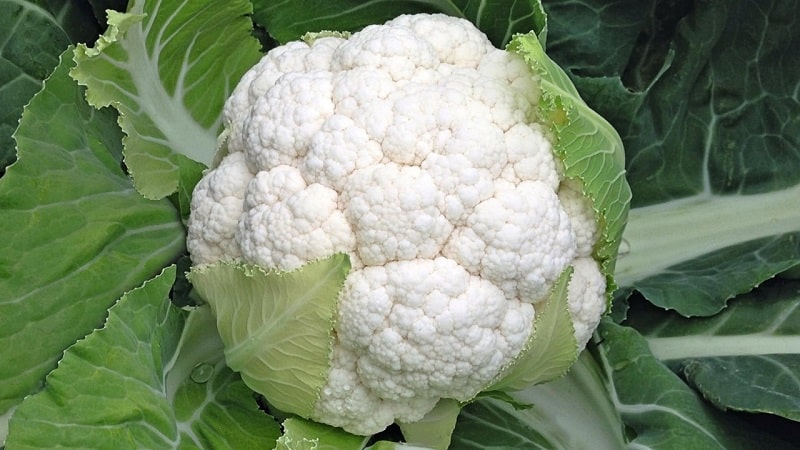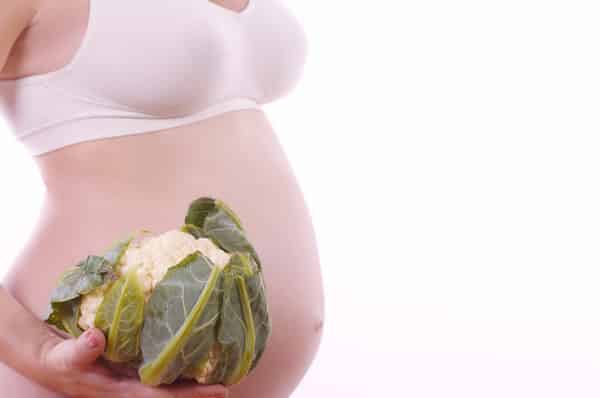Is it possible to eat cauliflower raw and for whom is it contraindicated?
Not all people know about the benefits of cauliflower. Nevertheless, this vegetable, in addition to its unusual taste, has many positive qualities. It can be eaten both after heat treatment and raw. In the latter case, all vitamins and microelements necessary for human health are completely preserved.
What's good about cauliflower?
Vegetables contain many substances that have anti-carcinogenic and anti-inflammatory properties. In addition, its regular use helps improve brain function, prevents cardiovascular diseases and excess weight gain.

Composition and properties
All types of cabbage have beneficial qualities, but cauliflower varieties are superior to them with their rich composition:
- vitamins A, B, C, E, D, K, H, U;
- organic acids;
- purine compounds;
- amino acids;
- polyunsaturated acids;
- starch;
- natural sugars;
- citric, folic, tartronic, malic acids;
- pectins.
The inflorescences contain a rare substance - biotin, which strengthens the nervous system, eliminates fatigue and depression and prevents the development of various skin diseases.
The medicinal properties of the vegetable are due to its rich mineral content:
- calcium;
- molybdenum;
- chlorine;
- potassium;
- zinc;
- sulfur;
- cobalt;
- manganese;
- phosphorus;
- copper;
- magnesium;
- gland;
- sodium
KBZHU
Given its complex chemical composition, the calorie content of raw cauliflower is insignificant - 100 g of product contains only 29 kcal.
Nutritional values:
- fats – 0.5%;
- dietary fiber – 10.5%;
- carbohydrates – 1.7%;
- proteins – 5%.
Despite the low calorie content, it is very easy to get enough of the inflorescences, due to their nutritional value.
Benefits and harms

Due to its beneficial qualities, the vegetable is used as a medicine to combat various diseases, as well as for prevention in order to improve health.
Basic properties:
- anticarcinogenic effect;
- normalization of metabolic processes and hormonal levels;
- prevention of malignant neoplasms;
- protecting healthy cells from damage;
- strengthening blood vessels and bone tissue;
- stimulation of regeneration;
- removal of toxins and waste from the body;
- improvement of bile outflow;
- blood purification;
- strengthening the immune system;
- rejuvenation due to the content of enzymes.
Folic acid, which is part of the product, has a beneficial effect on the condition of the female body, slows down the onset of menopause, and reduces stress from hormonal changes.
For men, the beneficial properties of the vegetable include reducing the risk of developing prostate cancer, maintaining the necessary energy balance and giving the body tone.
Since the product stimulates the secretion of gastric juice, it is recommended that people with stomach diseases limit their consumption of raw inflorescences. This also applies to the elderly, those with gout or urolithiasis. It is worth exercising moderation due to the high content of purines in the vegetable. Crystals are deposited in the body in the form of salts.
Studies have shown that excessive consumption of raw vegetables contributes to decreased thyroid function. Moreover, only people with a lack of iodine in the body are susceptible to the development of hypothyroidism.
Important! For diseases of the thyroid gland, inflorescences can be consumed only after heat treatment and no more than once a day.
Medicinal properties for various diseases
The medicinal qualities of the product are used for the treatment and prevention of many different diseases:
- arrhythmias;
- diabetes mellitus;
- obesity;
- ulcers;
- skin damage and burns;
- anemia;
- kidney and liver pathologies;
- bronchial asthma;
- stomatitis;
- constipation;
- pneumonia;
- hemorrhoids.
For weight loss
Low calorie content, minimal fat and carbohydrate content with a simultaneous abundance of fiber have made the vegetable a recommended product when losing weight. Raw inflorescences stimulate the removal of excess fluid and toxins from the body, which significantly improves a person’s well-being.
It is also worth highlighting several more factors that contribute to weight loss:
- the tartronic acid included in the composition prevents the conversion of carbohydrates into fat deposits (lipogenesis processes);
- to digest this vegetable, the body spends 1.5 times more energy than other crops;
- the presence of methylmethionine blocks attacks of depression, which often occur during fasting.
Obtaining the desired effect is possible only by consuming at least 120 g of the product per day.
During pregnancy and pregnancy

The benefits of vegetables during pregnancy are as follows:
- preventing excess weight;
- formation of a strong skeletal system in the fetus;
- improving the functioning of the heart muscle of the expectant mother;
- prevention of hypoxia and anemia in baby;
- blocking depression, ensuring stable mood;
- cleansing the gastrointestinal tract, normalizing the frequency of bowel movements;
- formation of the fetal nervous system, significant reduction in the risk of developing central nervous system pathologies.
During lactation, experts recommend including cauliflower in the diet approximately 20 days after birth.
Effect of the product on the body of a nursing woman:
- Reducing the risk of infectious and viral diseases, strengthening the immune system due to the high content of vitamin C.
- Reducing blood cholesterol levels, normalizing the amount of lipids.
- Prevention of breast cancer.
- Stimulation of metabolic processes and intestinal function.
- Prevent gas formation and colic.
When the first signs of allergy occur in a nursing mother or baby stop using the product immediately.
Is it possible to eat cauliflower raw?
The vegetable belongs to the category of products allowed to be consumed raw. In this case, the maximum amount of nutrients and vitamins is preserved. For example, heat treatment promotes the decomposition of vitamins A, as well as PP and B, significantly reducing their amount.
The low fiber content and its delicate structure virtually eliminate any irritating effects on the gastric mucosa.
Advantages and disadvantages of this method of use
The advantage of consuming the product raw is that you receive the full amount of vitamins and beneficial microelements contained in the vegetable. Disadvantages include the presence of contraindications and less vibrant taste than thermally processed dishes.
How to choose cabbage that is suitable for eating raw
Most of the beneficial properties of cauliflower last no more than 12 days.. To choose the freshest vegetable possible, it is important to pay attention to several nuances:
- density and weight of the head of cabbage;
- the presence of tight green leaves around the inflorescences;
- white or yellowish tint of the head, in rare cases red-blue, purple or green is found;
- absence of dots and dark spots, mold, and yellow or tan tint.
Even under suitable conditions, fresh vegetables can be stored for no more than one week. If you purchase cut inflorescences, it is recommended to consume them within 2 days.
Important! Fresh heads of cabbage sit firmly on the stalks, creating the impression of solidity.
How to eat raw
In their raw form, the inflorescences are eaten in different ways, for example, like an apple, but it is best to add this vegetable to salads. There are many recipes for preparing delicious cold dishes from fresh cauliflower.
There are several foods that go well with raw buds:
- banana;
- vegetable oil;
- green garlic;
- lemon;
- soy sauce;
- boiled chicken meat;
- any type of onion (especially red salad);
- raisin;
- wild garlic;
- yogurt;
- greenery;
- corn;
- low-fat sour cream;
- green pea;
- cucumbers;
- ham.
What parts are there
Cauliflower inflorescences are mainly eaten raw. As for the stump, it is characterized by excessive rigidity.
Cooking methods

We offer the most famous recipes with fresh heads of cabbage.
Option #1
Components:
- 300 g of inflorescences;
- ½ lemon;
- 30 g raisins;
- 3 tsp. ground walnuts;
- 1 garlic clove;
- salt (to taste);
- 1 tbsp. l. olive oil;
- 1 tsp. honey
Preparation:
- Place cabbage disassembled into small inflorescences in water with lemon juice.
- Soak the raisins.
- To obtain the dressing, grind the nuts and add lemon juice.
- Add honey, olive oil, salt and pressed garlic to the sauce. Beat the mixture until a homogeneous consistency is obtained.
- Combine cabbage with raisins, pour honey-nut sauce and let it brew.
In about 30 minutes the dish will be ready to eat. Before serving, sprinkle with chopped nuts.
Option No. 2
Ingredients:
- 300 g of inflorescences;
- 1 carrot;
- 1 cob of corn;
- dill, parsley (to taste);
- cold pressed vegetable oil;
- sea salt (to taste).
Preparation:
- Cut the kernels from the cob.
- Grind the heads of cabbage.
- Grate the carrots.
- Chop the greens.
- Mix all ingredients, add vegetable oil and mix thoroughly.
The finished salad is decorated with greens on top.
Option #3
Components:
- 100 g of inflorescences;
- ½ lemon;
- ½ banana;
- cream (to taste);
- raisins to taste.
Preparation:
- Combine the vegetable cut into small pieces with banana slices.
- To make the sauce, whip the cream and mix with lemon juice and raisins.
- Season the salad with the prepared mixture.
Option No. 4
Ingredients:
- 1 medium-sized head of cabbage;
- 1 onion;
- a bunch of dill;
- 100 ml yogurt;
- 1 cucumber;
- 50 ml sour cream;
- 30 ml soy sauce.
Preparation:
- Cut the washed and dried cabbage into small pieces.
- Chop the vegetables and herbs and add to the inflorescences.
- Beat sour cream with yogurt and soy sauce.
- Season the salad with milk dressing.
It is permissible to add finely chopped boiled chicken to the finished dish.
Option #5
Components:
- 1 head of cabbage;
- 250 g ham;
- ½ can of green peas;
- 1 cucumber;
- 3 tbsp. l. vegetable oil;
- salt (to taste).
Preparation:
- Cut the cabbage into small pieces, ham and cucumber into slices.
- Mix the ingredients, add salt, then add vegetable oil.
Option #6
A simple recipe from fresh inflorescences contains the following ingredients:
- 1 head of cabbage;
- 1 large fresh tomato;
- several lettuce leaves;
- vinegar, salt and vegetable oil - to taste.
Preparation:
- Chop the cabbage.
- Mix vinegar with vegetable oil and add salt to the resulting sauce.
- Add dressing to the florets and top with tomato slices.
Contraindications
It is recommended to limit or refrain from consuming raw inflorescences in the following cases:
- diseases of the gastrointestinal tract;
- individual intolerance;
- pathology of the genitourinary system and kidneys;
- the presence of an ulcer;
- excess gastric acidity.
The inclusion of the product in the daily diet when switching to a diet is permissible only after preliminary consultation with a specialist.
Important! Eating vegetables should be stopped if diabetes worsens.
Conclusion
When used correctly and strictly following optimal dosages, raw cauliflower inflorescences will not only not cause harm to human health, but will also saturate the body with vitamins and beneficial microelements. In addition, consuming the product will alleviate the course of certain diseases and thereby significantly improve the condition.